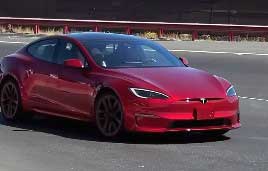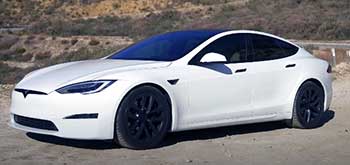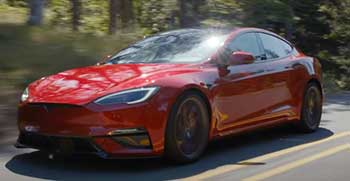
I’ve always been fascinated by Tesla’s ability to push the boundaries of electric vehicles, blending jaw-dropping performance with futuristic tech.
In this article, I’m taking you on my exploration of the Tesla Model S and Model X, comparing their features, performance, and practicality through my own lens as a driver and EV enthusiast.
From their sleek designs to their real-world usability, I’ll break down the pros, cons, and maintenance tips, helping you decide which Tesla suits your lifestyle.
Whether you’re after speed or space, this comparison will guide your choice with clarity and excitement.
Comparison Table
| xFeature | Tesla Model S | Tesla Model X |
|---|---|---|
| _Price (Starting) | $81,630 | $86,630 |
| _Body Style | Sedan | SUV |
| _Seating Capacity | 5 | Up to 7 |
| _Range (EPA Estimated) | 402 miles (Long Range) | 329 miles (Long Range) |
| _0-60 mph | 3.1 sec (Long Range) | 3.5 sec (Long Range) |
| _Cargo Space | 28 cu ft (trunk) + 5 cu ft (frunk) | 37 cu ft (rear) + 6.5 cu ft (frunk) |
| _Horsepower | 670 (Long Range) | 670 (Long Range) |
| _Top Speed | 155 mph (Long Range) | 155 mph (Long Range) |
| _Drive Type | All-Wheel Drive | All-Wheel Drive |
| _Unique Feature | Sleek aerodynamic design | Falcon Wing doors |
My Experience With Tesla Model S
Driving the Tesla Model S feels like piloting a spaceship disguised as a sedan. The first time I slid behind the steering yoke, I was struck by its minimalist interior—almost no buttons, just a massive 17-inch touchscreen dominating the dashboard.
It’s a car that screams performance, and it delivers. Flooring the accelerator in the Long Range model, I hit 60 mph in 3.1 seconds, a rush that pinned me to my seat and left me grinning like a kid. The handling is razor-sharp, hugging corners with a low center of gravity that makes it feel planted, even on winding roads.
The Model S is a dream for long drives. On a road trip from San Francisco to Los Angeles, I managed 380 miles on a single charge, thanks to its impressive 402-mile EPA-estimated range. Tesla’s Supercharger network made recharging a breeze, with a 30-minute stop adding enough juice for the next leg.
The cabin is quiet, and the panoramic glass roof gives a sense of openness, though I noticed the rear seats can feel snug for taller passengers. The tech, like Autopilot, handled highway cruising effortlessly, though I kept my hands on the yoke for safety.
However, it’s not all perfect. The touchscreen controls everything—climate, media, even the wipers—which can be distracting when you’re trying to adjust settings on the fly.
I also found the lack of Apple CarPlay frustrating, as Tesla’s proprietary system, while slick, doesn’t integrate with my phone as seamlessly as I’d like. Still, the Model S is a performer’s car, built for those who crave speed and efficiency without sacrificing luxury.
Pros Of Tesla Model S
- Blistering Acceleration: The Model S Long Range hits 0-60 mph in 3.1 seconds, and the Plaid version does it in a mind-bending 1.99 seconds, making it one of the fastest production cars ever.
- Impressive Range: With up to 402 miles per charge, it outpaces most EVs, perfect for long road trips without constant charging stops.
- Sleek Design: Its low-slung, aerodynamic silhouette turns heads and cuts through the air, boosting efficiency and style.
- Advanced Tech: The 17-inch touchscreen is a tech lover’s dream, controlling nearly all functions and offering Netflix and games for downtime.
- Low Maintenance: No oil changes or traditional engine repairs mean fewer trips to the shop and lower long-term costs.
- Supercharger Network: Tesla’s extensive charging infrastructure makes long-distance travel convenient, with fast charging adding 200 miles in about 30 minutes.
The Model S’s performance is unmatched in its class, and its range gives you confidence for cross-country adventures. I’ve driven it through city traffic and open highways, and it adapts seamlessly, with regenerative braking making stop-and-go driving smooth. The tech, while occasionally overwhelming, feels like a glimpse into the future, and the low maintenance costs are a huge plus for budget-conscious EV owners.
Cons Of Tesla Model S

- Pricey Base Model: Starting at $81,630, it’s a significant investment, especially when adding options like Full Self-Driving ($15,000 extra).
- Cramped Rear Seats: Taller passengers in the back complain about limited legroom, making it less ideal for families.
- Touchscreen Overload: Controlling everything via the touchscreen can be distracting, especially for simple tasks like adjusting mirrors.
- No Apple CarPlay/Android Auto: Tesla’s proprietary system lacks integration with popular smartphone platforms, which feels like a miss.
- Build Quality Concerns: Some owners report inconsistent panel alignment and minor interior rattles, which can detract from the premium feel.
- Limited Cargo Space: With 28 cubic feet in the trunk, it’s less practical than SUVs for hauling bulky items.
The touchscreen reliance took me a while to get used to, and I fumbled a few times trying to adjust settings while driving. The rear seat space was a noticeable drawback when I had friends along for a weekend trip—those over 6 feet tall weren’t thrilled. Build quality issues haven’t been a major problem for me, but I’ve heard enough complaints to keep it in mind.
Also read: My Thoughts on Ford Edge Vs. Hyundai Tucson
Maintenance Tips For Tesla Model S
- Monitor Tire Wear: High torque means tires wear faster, especially on Plaid models. Check tread depth monthly and rotate every 6,000 miles.
- Keep Software Updated: Tesla’s over-the-air updates improve performance and fix bugs. Ensure your car is connected to Wi-Fi for seamless updates.
- Clean Charging Port: Dust and debris can accumulate in the port. Gently clean it with a soft brush to maintain efficient charging.
- Check Brake Fluid: Though regenerative braking reduces wear, inspect brake fluid every two years to ensure optimal performance.
- Wiper Blade Replacement: The large windshield requires specific blades. Replace them annually to maintain visibility in harsh weather.
- Cabin Air Filter: Swap the filter every two years to keep air quality high and prevent strain on the HVAC system.
Maintaining the Model S is straightforward compared to gas-powered cars. I check my tires regularly, especially after spirited drives, and keep the software updated to enjoy new features like improved navigation. Cleaning the charging port is a quick task I do monthly, and it’s saved me from slow charging issues. The low maintenance needs make ownership hassle-free, but staying proactive with these tasks keeps the car in top shape.
My Experience With Tesla Model X
The Tesla Model X is a different beast—a towering SUV that feels like a luxury fortress on wheels. My first drive was unforgettable, thanks to the Falcon Wing doors that opened upward with a futuristic flair, drawing stares at every stoplight.
Inside, the massive windshield stretches over the front seats, giving a panoramic view that makes every drive feel cinematic. The Long Range model’s 670 horsepower delivered a 0-60 mph sprint in 3.5 seconds, impressive for an SUV that can seat up to seven.
On a family camping trip, the Model X shone. Its 37 cubic feet of rear cargo space swallowed gear for four people, and the frunk added extra storage for smaller items. The seven-seat configuration was a game-changer, comfortably fitting adults and kids, though the third row is best for shorter trips.
Autopilot made highway stretches relaxing, and the Supercharger stops were quick, though the 329-mile range meant more frequent charging than the Model S.
The downsides? Those Falcon Wing doors, while cool, are slow to open in tight spaces, and I worried about their reliability long-term.
The Model X’s higher price—starting at $86,630—stings, especially when you add seating upgrades or Full Self-Driving. It’s also wider than most SUVs, making parking lots a challenge. Still, for families or those needing space, the Model X is a versatile, high-tech marvel.
Pros Of Tesla Model X

- Spacious Interior: Seats up to seven with roomy second and third rows, ideal for families or group outings.
- Falcon Wing Doors: These upward-opening doors are a showstopper and make accessing the rear seats easier in tight spaces.
- Ample Cargo Space: With 37 cubic feet in the rear and 6.5 in the frunk, it handles everything from groceries to camping gear.
- Powerful Performance: The Long Range model’s 670 horsepower and 3.5-second 0-60 mph time rival many sports cars.
- High Ground Clearance: The adjustable air suspension makes it great for light off-road adventures or snowy conditions.
- Advanced Safety: Five-star Euro NCAP ratings and features like automatic emergency braking keep passengers secure.
The Model X’s versatility is its biggest strength. I loved how it handled family trips with ease, and the Falcon Wing doors made loading kids and gear a breeze in crowded parking lots. The performance is thrilling for an SUV, and the safety features gave me peace of mind on busy highways. It’s a premium choice for those who need space without sacrificing Tesla’s signature tech.
Cons Of Tesla Model X
- Higher Price Tag: Starting at $86,630, it’s pricier than the Model S, with options like seven seats adding $3,500.
- Falcon Wing Door Issues: They’re slow to open and can be problematic in low-ceiling garages or with long-term reliability.
- Shorter Range: The 329-mile EPA-estimated range lags behind the Model S, requiring more frequent charging on long trips.
- Wide Body: At 81.5 inches wide, it’s tricky to maneuver in tight parking spaces or narrow streets.
- Touchscreen Dependence: Like the Model S, all controls are on the touchscreen, which can be distracting while driving.
- Build Quality Variability: Some owners report panel gaps and interior creaks, which feel out of place for the price.
The Model X’s width made me nervous in tight city parking, and the shorter range meant planning an extra Supercharger stop on longer drives. The Falcon Wing doors are a mixed bag—cool but impractical in some situations. Like the Model S, the touchscreen can be a hassle, and I’ve noticed minor fit-and-finish issues that don’t match the premium price.
Maintenance Tips For Tesla Model X
- Inspect Falcon Wing Doors: Regularly check door sensors and hinges for debris or wear to prevent malfunctions.
- Monitor Air Suspension: Test the adjustable suspension monthly and listen for unusual noises, as repairs can be costly.
- Clean Panoramic Windshield: Use a mild cleaner to avoid streaks on the massive glass, especially in rainy conditions.
- Check Tire Pressure: The heavier SUV puts more strain on tires; maintain proper pressure to extend tire life.
- Update Software Regularly: Connect to Wi-Fi for over-the-air updates to optimize performance and fix door or suspension issues.
- Battery Health Check: Schedule a Tesla service check every two years to monitor battery degradation, especially for high-mileage vehicles.
The Model X requires a bit more attention than the Model S due to its complex doors and air suspension. I make a habit of cleaning the windshield weekly to keep the view crystal clear, and I check the suspension settings before off-road trips. Software updates have resolved minor glitches with the doors, and keeping tires properly inflated has saved me from premature wear.
Comparison With Other Brands
- Lucid Air vs. Model S: The Lucid Air offers up to 512 miles of range, outpacing the Model S, but its $69,900 starting price is close, and it lacks Tesla’s Supercharger network. The Air’s interior feels more luxurious, but the Model S’s performance and tech are hard to beat.
- BMW iX vs. Model X: The iX starts at $87,250 and offers a plush interior with 301-355 miles of range. Its conventional doors are less flashy but more reliable than the Model X’s Falcon Wings, though it can’t match Tesla’s acceleration or charging infrastructure.
- Rivian R1S vs. Model X: The R1S, starting at $75,900, is a rugged seven-seater with 316-400 miles of range. It’s better for off-roading but lags in tech and charging speed compared to the Model X’s polished SUV experience.
- Mercedes-Benz EQE vs. Model S: The EQE starts at $74,900 with a 298-mile range and a refined interior. It offers Apple CarPlay, which the Model S lacks, but its performance and range fall short of Tesla’s sedan.
- Audi Q8 e-tron vs. Model X: Starting at $74,400, the Q8 e-tron has a 285-mile range and a smoother ride. It’s less powerful than the Model X and lacks the Tesla’s tech edge, but its build quality is more consistent.
The Model S holds its own against the Lucid Air and EQE, especially for performance enthusiasts, but its tech quirks and build quality can’t always compete with luxury rivals. The Model X faces stiff competition from the R1S and iX for family SUVs, but its unique doors and Tesla’s charging network give it an edge for tech-savvy buyers.
Read more: My Thoughts on Honda Odyssey Vs. Subaru Ascent
Frequently Asked Questions (FAQ)
The Model S is a sleek sedan with a 402-mile range and sportier handling, while the Model X is an SUV with up to seven seats, Falcon Wing doors, and a 329-mile range, prioritizing space over range.
Tesla hasn’t stopped making the Model S. It remains in production, with recent updates like the Plaid trim, though sales have slowed due to the popularity of the Model 3 and Y.
The Model 3, starting at $44,130, offers the best value with a 358-mile range and solid performance, but the Model S provides more range and power for those willing to spend more.
The Model X’s higher price ($86,630 vs. $81,630 for the Model S) comes from its larger SUV body, Falcon Wing doors, adjustable air suspension, and optional seating for up to seven.
Conclusion: For Tesla Model S
If you’re a thrill-seeker who loves speed and a sleek design, the Tesla Model S is your match. Its longer range and blistering acceleration make it a standout for solo drivers or small families. You’ll love the tech, but be ready for a learning curve with the touchscreen. For me, it’s the ultimate electric sedan.
Conclusion: For Tesla Model X
If you need space for family or gear, the Tesla Model X is your go-to. Its Falcon Wing doors and versatile seating are perfect for larger groups, though the higher price and shorter range are trade-offs. You’ll feel like you’re driving the future, and I found it ideal for group adventures.

